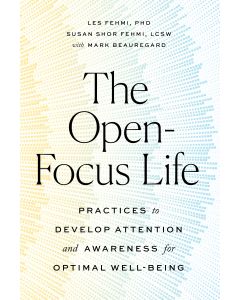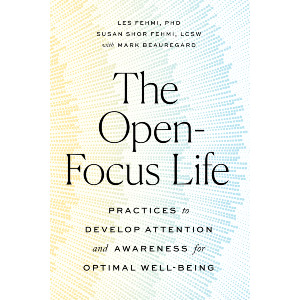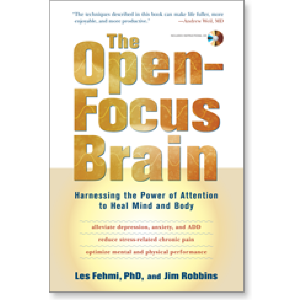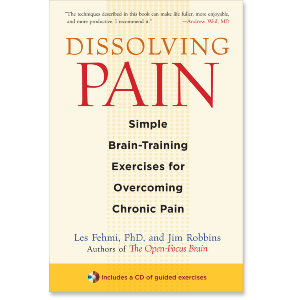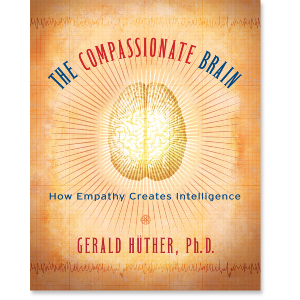

Mark Beauregard
GUIDES

Finding Rest Through the Open-Focus Method
An excerpt from The Open-Focus Life
The clock shows three o’clock in the morning. It’s a night like many others, when you can’t fall asleep, or you drift off for an hour and then wake up in a panic about something you can’t remember, chasing endless worries.
Now you’re thinking about work again, worrying about how you’re going to get the money to pay that bill, the stupid argument you had on Facebook with someone you don’t even know about something you don’t really care about. Where is that barking dog? Does one of your neighbors have a new dog?
The meditation book said you should observe the thoughts without following them, just notice the thoughts that you’re having without participating in them, but even when you’ve managed to do that for a few moments, the thoughts have popped back up again, and the more worrisome thoughts suck you right back in. Melatonin works sometimes, tryptophan works sometimes, chamomile tea—but now you’re just thinking about all the sleep remedies that don’t work instead of actually sleeping. If only you’d had time to get to the gym today—and now you’re beating yourself up about all the things you should have done differently throughout the day, or throughout your whole life. You wonder if you should get up and take a sleeping pill—but then your mind will be shrouded in a thick fog when you have to get up for work four hours from now. Why are these anxious thoughts plaguing you? Where do they come from?
An even better question would be: Where are these thoughts right now?
The psychological term for thoughts is “mental representations,” and they occur mainly in your brain. But what about that stress you feel about the bills, that vague stomachache, the worry about your insurance? What about your changing moods as you struggle to fall asleep—are they “mental representations” as well? Partly, but neuroscientists have been able to determine that different moods produce and are caused by different chemical reactions that occur all over your body. Modern science in many ways confirms the folk wisdom we developed as a culture over the course of thousands of years: what we perceive as sadness, for example, occurs simultaneously in our brains and in chemical changes in and around our hearts, which is why sadness gives rise to words like “heartsick,” “heartache,” and “heartbreak.” Emotions like stress are associated with the biochemistry of the stomach (an irritating encounter can be “gut-wrenching”; a stressful situation can give you “butterflies in your stomach”), and fear and anger are associated with nerves in the lower parts of the digestive system, which find expression in vulgar sayings that represent the taboos associated with those volatile emotions (you can get “pissed off,” for example, and really “lose your shit”). These mental representations or thoughts that are keeping you awake are happening in your brain, and they’re also occurring throughout your body. Locating them in your brain and also in your body, in the space that your brain and body occupy, is the first step in really inhabiting your thoughts and feelings, really becoming one with them.
You might ask: Why would I want to become one with my unpleasant thoughts and emotions? Because they’re already part of you, and the fact that they are keeping you awake means that you are separating yourself from them, that you are paying attention to them in a way that distances you from your feelings and makes them painful. Your attention on them has become too narrow and objective, and instead of seeming like part of you, they have come to seem different from you, to seem like they’re happening to you—but in reality, they are not separate from you. They are occurring in your body, in the space that you physically occupy, and paying attention to them as part of your physical space, integrating them into your body, is the secret to calming them and falling asleep.
If you are feeling stress and worry about a relationship, for example, try imagining the distance between your brain and your heart, where that anxiety can reside. Can you imagine the space between your ears, where your worried thoughts are occurring?
Imagine that space in your head where your thoughts are going on. When you have imagined that space, between your ears, behind your eyes, then imagine the distance between that space and the space that your heart occupies. While you keep imagining the distance between your brain and your heart, can you also imagine the space between your heart and your stomach, where the adrenalin of your worries is constricting your blood vessels and causing what can be a churning feeling? Can you feel that space in and around your stomach? Allow yourself to feel it, however intense it might be. Now imagine the distance between your stomach and your heart again. Your heart is beating. Notice your breathing, how the breath coming in and out of your nose and mouth, your throat and lungs, can show you the rate of your heart. Can you imagine the distance between your heart and your jaw? Now imagine the distance between your jaw and the space between your eyes. Can you imagine connecting that space that contains your eyes, your mouth, and your jaw to the space in your throat and down to your heart?
Your worried thoughts are part of your body and the space that your body occupies, and your body is just a small part of the space in your room.
As you imagine the distance between your head and your heart, between your heart and your stomach, can you imagine at the same time becoming aware of your lower organs? Can you imagine also including the space that your hips and legs and feet occupy?
When you imagine the space that your body occupies, you are also imagining the true nature of your thoughts, which are physical processes occurring in physical space. Now, can you imagine the distance between your feet and the bedroom wall? And between the wall nearest your feet and the wall nearest your head? Can you imagine connecting the space between those two walls through your body, which includes your feet and your hands, your stomach, your heart, your jaw, and your eyes?
When you feel your anxious thoughts as fully part of your body and become one with them, as you truly are, your worries will become what they really are—just another part of the space that is your body, lying atop the space that is your bed. Between the walls of your bedroom, there is nothing but space, including your body—the space where you lie, comfortably. Now, can you imagine the distance between the top of your head and the soles of your feet, including your heart and your stomach and your lower organs, your arms and your legs? And can you imagine the space all around your body, on every side, including above you and below you? Take a moment to do this, to connect all of these spaces in your imagination just as they’re actually connected in physical reality.
The thoughts flowing through your body are part of this space. Can you imagine your thoughts as just a tiny part of the space that is your body and an even smaller part of the space that is this room and an even smaller part of the space all around your room? Can you imagine your thoughts as a tiny part of the whole physical world around you—above, below, and on every side of you? Close your eyes and let your thoughts be the tiny part of this space that they really are and that you really are. Allow yourself to be the physical space within you and all around you.
Share
Related Books



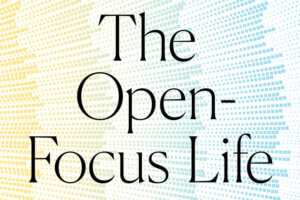
Online Meetings Stressing You Out? Try Opening Your Focus
By Mark Beauregard
Co-author of The Open-Focus Life
Do you feel mentally or emotionally exhausted after Zoom meetings? Is it difficult to concentrate? Do you have physical symptoms that seem to have nothing to do with sitting and looking at a computer screen, like muscle pain, backaches, or shortness of breath?
The emotional, psychological, and physical challenges of video conferencing go beyond simple eyestrain and work stress. “Virtual fatigue,” the emotional exhaustion that comes from constant video meetings and online interactions, resembles other kinds of burnout and has similar effects, including insomnia, irritability, and forgetfulness.
Focusing very narrowly on the screen in front of you, especially when you’re required to react in real time to real people on the other side of that screen, activates your body’s Fight-Flight-Freeze response.
According to Stanford University professor Jeremy Bailenson, seeing a group of faces staring directly at you triggers a subconscious preparation for conflict, because such prolonged, intense, face-to-face encounters with groups have generally indicated danger throughout our evolutionary history. In addition to the more conscious stressors you might be experiencing because of your job or the subject of the meeting, these unconscious stressors increase your heart rate, blood pressure, and production of stress-related hormones. In a real-life stressful encounter with a group, you could choose fight or flight and release some of that stress through action, but in a virtual meeting, you can only freeze, sitting there immobile in front of the screen. Your body is stressed out because the way you’re paying attention is telling all of your internal systems that you’re in a crisis.
The good news is that you can shift out of this emergency mode of attention during your next Zoom meeting, and you can start right now, even as you’re reading this article, by opening your focus.
What is Open Focus?
All my life, whenever someone told me to focus, they meant that I should narrow my field of awareness and concentrate on just the one thing right in front of me. But the Princeton neuroscientist who developed Open Focus, Dr. Les Fehmi, intentionally called his method by that name to inspire this very question: how do you focus in an open way?
I’ll show you right now. I’m going to ask you to shift your attention several times in the following passage, and as you do so, please keep reading. You’ll see how your focus—how you pay attention—can open and change.
Words are a kind of magic: they contain thoughts and meanings that seem to bypass physical space and enter an entirely mental realm. But these words you’re reading are appearing on a physical surface, and they’re traveling through physical light to your eyes, which are also physical organs. Even the mental realm—the way you’re understanding these words—requires blood flowing from your heart to your brain, electrical impulses jumping across synapses, neurons physically connecting to one another. Reading this article is an intensely physical activity, and focusing only on the words as your eyes scan across the screen is just one small aspect of the overall attention available to you.
As you read, focus for a moment on the black lines that make up the words themselves, black shapes against the white background, and notice the space around the words. You’re understanding the words, but you’re also seeing the spaces between the words and letters, and you’re seeing the space that exists between your eyes and the screen, even though there’s nothing visible in that space. Now, as you continue reading, notice the space around the device you’re looking at. If you’re holding a tablet or phone, notice your hands holding the device and feel its physical weight, the texture of the plastic, or feel your fingers against the keyboard. As you continue to read, allow your awareness to widen out and let in the details not just of the screen around these words but the space around the screen, the space that you’re physically in. We’re so accustomed to focusing narrowly on the thing right in front of us, the “most important” thing that we’re doing or concentrating on, that often the space that we’re in disappears into the background, but you can be aware of the objects around this screen and even the physical object of the screen itself and the distance between your face and the screen, all at the same time, while you’re continuing to read and understand these words.
Allowing all of these elements into your awareness is the first simple step in opening your focus. Paying attention in a more open way, to everything in your visual field at once and not just the screen, is exactly how your brain wants to pay attention—it’s how human beings evolved to pay attention—and it has tangible physiological and emotional benefits, because how you pay attention affects your vascular, muscular, and endocrine systems, as well as your sympathetic and parasympathetic nervous systems. Opening your focus slows your heart rate, lowers your blood pressure, and allows your brain to produce more alpha waves, meaning a state of more calm.
Opening Your Focus in a Virtual Meeting
In exactly the same way that you’ve just done reading this article, you can open up your attention to let in more physical details of your actual environment the next time you participate in a virtual meeting. Your eyes are already seeing the room or wall or window behind your screen, and the space to the left and right of you—letting those visual sensations into your conscious awareness is just a matter of shifting your attention so you allow yourself to see them. You don’t even have to look in another direction—just allow all of those objects and sounds around the screen and around your body to be present in your awareness. Letting the sights, sounds, and sensations of your actual space into your conscious awareness during your next Zoom, instead of fighting them and trying to shut them out, will actually allow you to hear and remember what people are saying in virtual space better, because your body won’t be artificially in crisis mode, which inhibits memory. This is true of even seemingly annoying or distracting sensations.
For example, in your next Zoom—as counter-intuitive as this may seem—try letting all of the sounds you’re hearing around you into your conscious awareness. Try it now, even just as you’re reading along. What sounds do you hear? For me, in the next room, I hear someone tapping on something wooden, tap-tap-tap. Down the street, I hear a heavy truck beep-beeping as it backs out of a construction site, and I also hear sparrows and cardinals chirping at the feeder outside my window. What sounds do you hear right now? Instead of trying to block them out during your next online meeting, you can simply notice them—you’re hearing them anyway, because the physical air is being disturbed by soundwaves that are reaching your physical ears, and they’re entering your awareness even as you try to block them out. Allowing yourself simply to be aware of the sounds of the people and activity in your environment instead of fighting them has measurable physiological benefits. Your brain and your body evolved to feel like they’re part of the physical environment, part of the space you’re physically in, so shutting out sensations and trying to disappear entirely into the digital world of the screen sends your autonomic nervous system into a mild panic. Again, as you just naturally read these words, can you imagine how far away the sounds you’re hearing are, locating yourself in space in relation to them, even as your eyes scan this line of text?
Opening your focus—including the visual space around the device you’re using, gently allowing your conscious awareness to include the sounds coming into your ears, feeling the weight and touch of your device against your fingers and hands—allows more of your brain to be involved in what you’re doing and brings your body back into sync with your mind.
If you lose yourself for a moment in narrowly focusing on the digital world of the screen during your next Zoom, you can just gently remind yourself of the physical space that you’re seeing between your eyes and the screen, the inert plastic edges of your device, and the room all around you. Letting in those other sights, sounds, and physical sensations will shift your body out of emergency mode into a calmer kind of attention—an open focus. It takes a little practice not to lose yourself in the screen, but you’ll feel better after that next meeting when you open your focus—less drained, less demoralized, and ready to enjoy the rest of your day.
Share
Related Books


